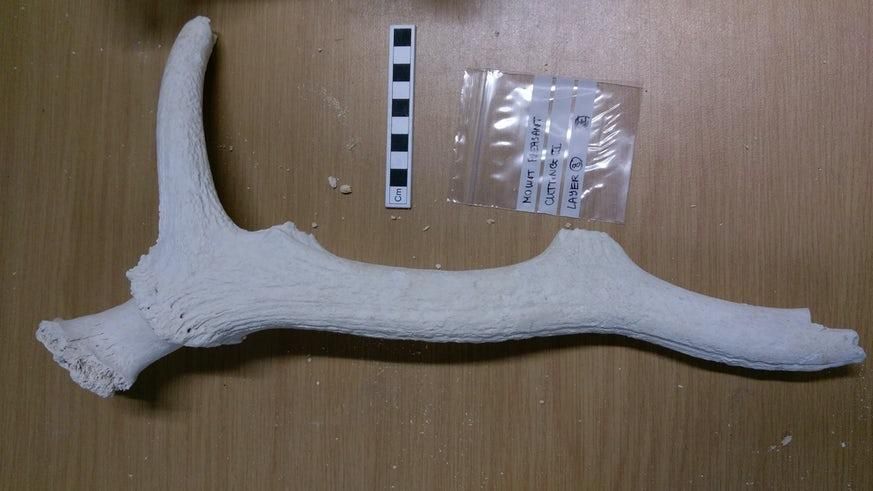Evidence of Neolithic Construction Boom Found at British ‘Mega-Henge’
New research suggests ancient humans built the Mount Pleasant henge in as little as 35 to 125 years
:focal(941x557:942x558)/https://tf-cmsv2-smithsonianmag-media.s3.amazonaws.com/filer/c6/03/c603be29-b143-4677-a9f5-2258fdbacbc1/henge_excavation.jpg)
Thousands of years ago, Neolithic humans in southern Britain constructed some of the most enduring evidence of early civilizations: enormous megaliths, including Stonehenge, used by generations of prehistoric peoples as sites for burials and rituals.
Some historians have argued that Neolithic workers built these henges over the course of centuries. But new research published in Proceedings of the Prehistoric Society suggests that ancient builders actually constructed one such structure—the Mount Pleasant henge just outside of Dorchester, England—in a much speedier timeframe of between 35 and 125 years.
Researchers proposed the revised timeline after radiocarbon dating artifacts recovered from the Mount Pleasant site. Though the items tested were excavated more than 50 years ago, they had not been analyzed with modern dating techniques until now, according to a statement from Wales’ Cardiff University.
As Steven Morris writes for the Guardian, the Mount Pleasant complex originally consisted of a timber-and-stone monument; a henge, or circular enclosure surrounded by a ditch; and a palisade, or fence made out of enormous felled trees. Per Rhys Blakely of the Times, workers felled thousands of trees and spent “millions” of hours constructing the enclosure.
Though the land on which the Neolithic henge stood has been ploughed over and turned into farmland, Historic England notes that key traces of the sprawling site remain intact. Mount Pleasant sits just south of Dorchester, about an hour’s drive south of Stonehenge.

To gauge the henge’s construction timeline, researchers dated artifacts excavated at Mount Pleasant in the early 1970s. These objects, which included remnants of antler picks, charcoal and human bones, now reside in the Dorset County Museum’s collections.
According to the statement, Neolithic workers used antler picks to dig the henge’s ditches, so the artifacts offer researchers a good indication of the timeframe in which the ditches were constructed. The team found that the pace of construction for Mount Pleasant was actually quite “frantic,” reports the Guardian. The whole complex could have been constructed in as little as 35 years and likely required no more than 125 years—much less time than previously thought, the researchers write.
“The building of Mount Pleasant would have involved a huge number of people—digging out the enormous ditches with simple tools like antler picks,” says lead author Susan Greaney, an archaeologist at Cardiff, in the statement. “Although the construction of the various parts took place in several phases, with successive generations working on its construction, all the work was concentrated within just over a century.”
Neolithic builders constructed Mount Pleasant around 2,500 B.C. Within a few centuries, a major shift took place in the region: New people started arriving from continental Europe, bringing different resources and beliefs and occasioning a shift from what historians would later label the Stone Age to the Bronze Age.
As the Guardian reports, the new Mount Pleasant timeline suggests that builders may have been spurred to work more quickly during this period due to demographic and cultural changes heralded by the newcomers’ arrival.

“This is right at the very end of the Neolithic period, right at the end of the Stone Age. What comes immediately afterwards is the arrival of people from the continent,” Greaney tells the Times. “They have the first metals that come into Britain and new ways of doing things—new types of pottery, probably new religious beliefs. They treat their dead in different ways. There’s a whole-scale shift.”
In the statement, Greaney adds, “What’s still not clear is why these monuments were built in the first place. Were people building these monuments as a ‘last hurrah’ because they could see change coming? Or did the effort and labor of building these monuments lead to a rebellion, a collapse in belief in the leaders or the religion, that created a vacuum in which new people could come in from the continent?”
Per the Times, Mount Pleasant is one of five known “mega-henges” in southern England. Others include Durrington Walls, a site located just two miles northeast of Stonehenge, and the Avebury henge in Wiltshire.
In a study published in June, researchers announced the discovery of deep pits surrounding the Durrington site. The chasms could have marked a large boundary around the enclosure, making it the largest prehistoric structure in all of Great Britain.
Whereas early humans likely used Stonehenge as a sacred place for ceremonies, they actually lived and feasted together at Durrington Walls.
In other words, said lead author Vincent Gaffney, an archaeologist at the University of Bradford, to the New York Times’ Megan Specia, “Stonehenge was for the dead, Durrington was for the living.”
/https://tf-cmsv2-smithsonianmag-media.s3.amazonaws.com/accounts/headshot/nora.png)
/https://tf-cmsv2-smithsonianmag-media.s3.amazonaws.com/accounts/headshot/nora.png)